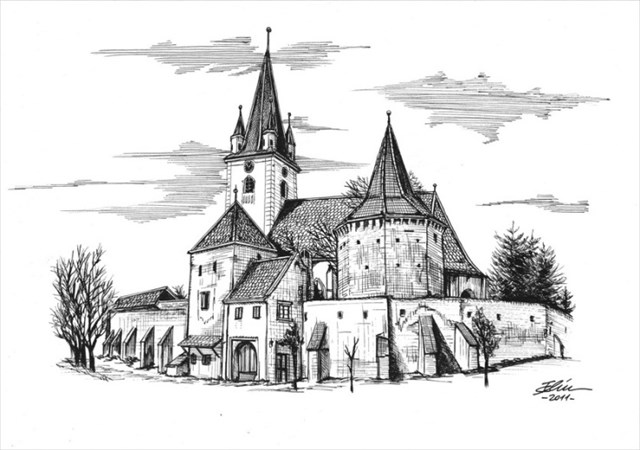Biserica fortificata Cristian - Grossau Traditional Geocache
Biserica fortificata Cristian - Grossau
-
Difficulty:
-

-
Terrain:
-

Size:  (micro)
(micro)
Please note Use of geocaching.com services is subject to the terms and conditions
in our disclaimer.
Cristian (Großau, Kereszténysziget) is a village near Sibiu. First is attested since 1223, as latin name Insula Christiana.The village was colonized at the request of the Hungarian king Géza II, during the first wave of colonization, between 1141 to 1161.
 The fortified church - Ink drawing on paper by Bogdan Calciu
The fortified church - Ink drawing on paper by Bogdan Calciu
[EN]: The Evangelical Lutheran Church from Cristian was built on the site of a Roman basilica wearing the patronage of St. Servatius. It still retains some original parts from the thirteenth century, namely: the lower floors of the bell tower , some bays with cross vaults of the north lateral nave and the semicircular windows traces of the central nave, filled later.
Towards the end of the XV-th century was rebuilt the naves, achieving a broad hall with four bays.The new church in late Gothic style was completed in 1495. From 1480 was kept a contract with the master Andreas Lapicida from Sibiu, on the work of stonemasonry. Perhaps in the thirteenth century the church was surrounded by a simple curtain, for around the year 1500 to be transformed into a strong fortress.The distance kept between the two walls is 3 m.In 1550 was built a secondary site,located on north of the main premises, and in 1580 a large octagonal tower. The church was burnt many times by the Turks, Tartars, southern mountaineers and plundered in 1599 by Michael the Brave. In 1690 the fortified church is held a meeting of the Diet of Transylvania. In 1775, the church receives an organ, built by Johannes Hahn. In 1805 the church tower was recovered after an earthquake and it was built the four corner towers.
[RO]: Cristian (în germană Großau, în maghiară Kereszténysziget) este o comună lângă Sibiu. Prima atestare documentară este din anul 1223, sub denumirea latină Insula Christiana. Localitatea a fost colonizată la cererea regelui Ungariei Géza II, în cursul primului val de colonizări, între 1141-1161.
Biserica evanghelică luterană din Cristian a fost construită pe locul unei bazilici romanice purtând hramul Sf. Servatius. Se mai păstrează câteva părţi originale din secolul XIII şi anume: etajele de jos ale clopotniţei cu tribuna de la etaj, câteva travee cu bolţi în cruce din nava laterală de nord şi urmele ferestrelor semicirculare ale navei centrale, astupate ulterior.
Către sfârşitul secolului XV s-au reconstruit navele, realizându-se o hală amplă cu patru travee. Noua biserică hală în stilul goticului târziu a fost terminată în anul 1495. Din 1480 s-a păstrat un contract cu meşterul sibian Andreas Lapicida, referitor la lucrările de pietrărie. Probabil că în secolul XIII biserica a fost înconjurată de o curtină simplă, pentru ca în jurul anului 1500 să fie transformată într-o cetate puternică, la care fortificaţia este o incintă dublă ce urmează un traiect pentagonal neregulat şi este întărită cu turnuri. Distanţa păstrată între cele două ziduri este de 3 m. În jurul anului 1550 a fost construită o incintă secundară, situată la N de incinta principală, iar în anul 1580 a fost construit turnul mare octogonal.
Biserica a fost incendiată de mai multe ori de turci, tătari, munteni din sud si prădată în 1599 de Mihai Viteazul. În 1690 se ţine în biserica fortificată o adunare a Dietei Transilvaniei, ocazie cu care nobilul Tököly Imre a fost ales principe al Transilvaniei. În 1775, biserica primeşte o orgă, construită de Johannes Hahn. În 1805 se reface şi se înalţă turnul bisericii, deteriorat de un cutremur. Tot atunci se construiesc şi cele patru turnuri de colţ.
Pentru vizitare, contactati pe Maria Mărășescu 0269-579350; 0751-146061.
O curiozitate a comunei - străzile nu au nume, ci sunt numerotate cu cifre romane.
[HU]: Kereszténysziget székely alapítású, napjainkban vegyes (német és román) ajkú község Nagyszebentől tíz kilométerre, nyugatra.
Alapításának ideje ismeretlen. Csak annyit tudni: kezdetben székelyek lakták. A 12. században II. Géza király szászokat telepitett ide. A község közepén álló, eredetileg háromhajós templomot a 13. századi tatárdúlás után kezdték építeni. A 15. században egységes csarnoktemplommá építették át. Ezzel egyidejűleg vastag erődfallal vették körül, amely udvarát két részre osztja. Az öt toronnyal megerősített védőfalhoz belülről kamrasor csatlakozik. Román stílusú alapokon nyugvó, gúlasisakos, négyfiatornyos tornyát 1498-ban a nagyszebeni András építőmester emelte. 1658-ban a törökök feldúlták Keresztényszigetet, lakóit lemészárolták.
A lakatlan települést 1660-ban osztrák telepesekkel népesítették be. 1690-ben, a német fővezér, Heisler tábornok és Teleki Mihály egyesített serege fölött Zernestnél fényes győzelmet arató Thököly Imre Keresztényszigetre rendelte a főrendeket országgyűlésre, ahol fejedelemmé választatta magát.
A védőtornyokkal és vastag fallal megerősített védmű viszonylag épségben vészelte át a történelem viharait. (szaszandras.info)
This cache wants to be the sequel of Grossau cache , hidden by paulms in 28 May 2007, lost in 2008.
This cache was part of the "TGQ2012" event.
Additional Hints
(Decrypt)
[EN]: jnyy
[RO]: mvq
[HU]: sny